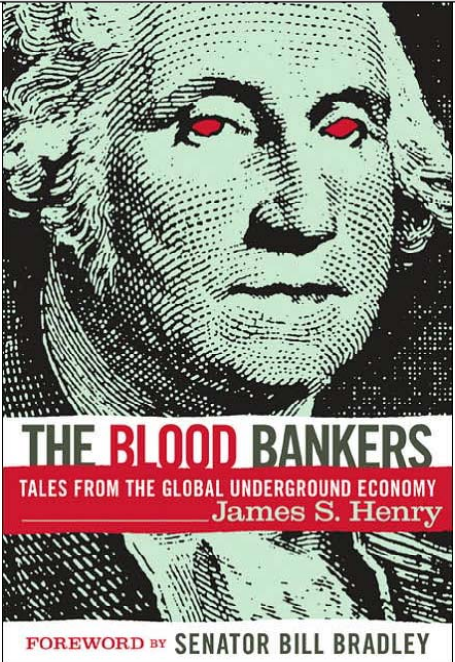The Blood Bankers: Tales from the Global Underground Economy by James S. Henry

C H A P T E R O N E
DEBT ELEPHANTS
In the carnival days from 1922 to 1929, when money was easy, many bankers
forsook the dignified, aloof attitude traditional of bankers and became, in
reality, high pressure salesmen of money.They carried on a cutthroat com-
petition against their fellow bankers, and once they obtained the business,
endeavored to urge larger loans on the borrowing countries.
—Francis White, US assistant secretary of state for Latin America, 19301
We know a great deal about who the poor are, where they are, and how they
live. We understand what keeps them poor and what must be done to
improve their lives.
—Barber Conable,World Bank president, 1990
All these projects are either finished or given up, so it’s not worthwhile to
speak about these dams. We are not politicians, and we have to look for
work. . . .
—senior executive, Lahmeyer International/RWE AG, 1999
One major piece of the puzzle about where all the money loaned to
developing countries went, in addition to capital flight, involved wasteful
projects. Many of these projects were started in the 1970s and 1980s, but they
had long-term effects—not only providing a fountain of corruption, capital
flight, and continuing environmental damage, but also laying the foundations
for the 1990s privatization boom, when many governments found themselves
trying to sell these elephants back to the private sector, or at least clean up
after them.To understand the foundations of the development crisis and the
prolonged consequences of these widespread “mistakes,” we’ll examine a cross
section of such projects in different countries and then draw some general
conclusions.
Almost everywhere one goes to research the history of the development
crisis, one hears a similar tale:
An official visits his friend, an official of another country, who has an
impressive estate, fancy cars, and a collection of polo ponies. “Confiden-
tially, how did you get so rich?” the first official asks.“I will show you,” says
the second. He takes his friend on a drive to a huge dam. “See that proj-
ect? Fifty percent.” Later, the second was visiting the first, who had an even
more impressive estate.“Confidentially, how did you get so rich?” the sec-
ond asks.“I will show you,” says the first.They take a drive to a river where
a major dam was supposed to have been built.“You see that dam?” the first
official says, pointing to the completely unobstructed river. “One hundred
percent.”
As Brazil’s Finance Minister Mario Enrique Simonsen once remarked, there
were many cases in which such “one hundred percent commissions” might
actually have been less wasteful than the monstrosities that were in fact con-
structed.The development crisis is not an abstraction—the carnage is every-
where.
BRAZIL’S PHARAOHS
To illustrate this point, we’ll start with Simonsen’s own Brazil, the world’s
fifth largest country, accounting for at least forty percent of South America’s
economic activity. Brazil, the Third World’s largest borrower in the 1970s, had
an unusual number of “pharaohnic” projects. It is also a fascinating case study
because its networks of influence and corruption were absolutely Byzantine,
and for most of the 1990s, neoliberals ruled the roost. One of them, Fernando
Collor, was booted out of the presidency in October 1992 after just two years
in office for corruption—the proceeds of which were laundered with the
help of several Miami private bankers. The other, Fernando Henrique Car-
doso, was a French-speaking political economy professor from the University
of Sao Paulo, a supposed Social Democrat. After winning the 1994 election,
he developed a taste for power and took a sharp rightward turn, implement-
ing a “strong reis” policy that stifled inflation and growth, slashed tariffs, and
barriers to foreign investment, and ordained the world’s largest privatization
program—partly to clean up all the debt elephants, but mainly to secure
another term in office.
After all this, today Brazil still remains the Third World’s largest debtor.
Indeed, it is now paying more debt service, as a share of national income, than
it did at the height of the 1980s debt crisis! It also has to generate even more
income to pay dividends to a hungry new crop of foreign investors. In 2002,
after all its “reforms of the 1990s,” Brazil still needed a $30 billion IMF bailout
to prevent it from following Argentina into default.And it is hardly out of the
woods. In late 2002 it elected Luis (“Lula”) Ignacio da Silva as president, a
bearded leftist metal worker from Pernambuco in Brazil’s Northeast. Lula had
been running for president since 1989. He was finally elected on his fourth
try because most Brazilians had become completely fed up with thirty years
The Blood Bankers: Tales from the Global Underground Economy by James S. Henry




